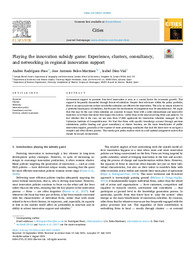Por favor, use este identificador para citar o enlazar este ítem:
https://hdl.handle.net/11000/34934Registro completo de metadatos
| Campo DC | Valor | Lengua/Idioma |
|---|---|---|
| dc.contributor.author | Belso-Martinez, José A. | - |
| dc.contributor.author | Rodríguez-Pose, Andrés | - |
| dc.contributor.author | Diez Vial, Isabel | - |
| dc.contributor.other | Departamentos de la UMH::Estudios Económicos y Financieros | es_ES |
| dc.date.accessioned | 2025-01-18T11:50:40Z | - |
| dc.date.available | 2025-01-18T11:50:40Z | - |
| dc.date.created | 2021 | - |
| dc.identifier.citation | Cities: The International Journal of Urban Policy and Planning | es_ES |
| dc.identifier.issn | 1873-6084 | - |
| dc.identifier.uri | https://hdl.handle.net/11000/34934 | - |
| dc.description.abstract | Abstract Government support to promote firm-level innovation is seen as a crucial factor for economic growth. This support is frequently channeled through firm-level subsidies. Despite their relevance within the policy portfolio, there is an open academic debate on whether subsidies are effective for innovation. This is by no means related to a potential inadequacy of subsidies, but because the mechanisms of assignment may be unsatisfactory. We argue that this may be the case when subsidies are awarded to larger firms with a solid international and innovative trajectory or to those that know how toplay the system,” rather than to the most deserving firms and projects. To test whether this is the case, we use data from 17,866 applicants for innovation subsidies managed by the Valencian Institute of Competitiveness. We find that firms with specific knowledge accrued through previous submissions, public funding and grant consultancy or cluster location, are the main beneficiaries of public innovation support, generally at the expense of more promising candidates that lack the know-how to navigate a complex and often flawed process. This inertia gets policy-makers stuck in a sub-optimal assignment system that should be deeply reconsidered. | es_ES |
| dc.format | application/pdf | es_ES |
| dc.format.extent | 10 | es_ES |
| dc.language.iso | eng | es_ES |
| dc.publisher | Elsevier | es_ES |
| dc.relation.ispartofseries | 119 | es_ES |
| dc.rights | info:eu-repo/semantics/openAccess | es_ES |
| dc.rights | Attribution-NonCommercial-NoDerivatives 4.0 Internacional | * |
| dc.rights.uri | http://creativecommons.org/licenses/by-nc-nd/4.0/ | * |
| dc.subject | Clusters | es_ES |
| dc.subject | Networks | es_ES |
| dc.subject | Innovation policy | es_ES |
| dc.subject | Consultancy services | es_ES |
| dc.subject | Previous subsidy experience | es_ES |
| dc.subject.other | CDU::3 - Ciencias sociales::33 - Economía | es_ES |
| dc.title | Playing the innovation subsidy game: Experience, clusters, consultancy, and networking in regional innovation support | es_ES |
| dc.type | info:eu-repo/semantics/article | es_ES |
| dc.relation.publisherversion | https://doi.org/10.1016/j.cities.2021.103402 | es_ES |

Ver/Abrir:
Cities.pdf
473,52 kB
Adobe PDF
Compartir:
 La licencia se describe como: Atribución-NonComercial-NoDerivada 4.0 Internacional.
La licencia se describe como: Atribución-NonComercial-NoDerivada 4.0 Internacional.
.png)